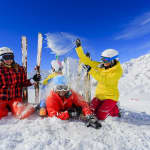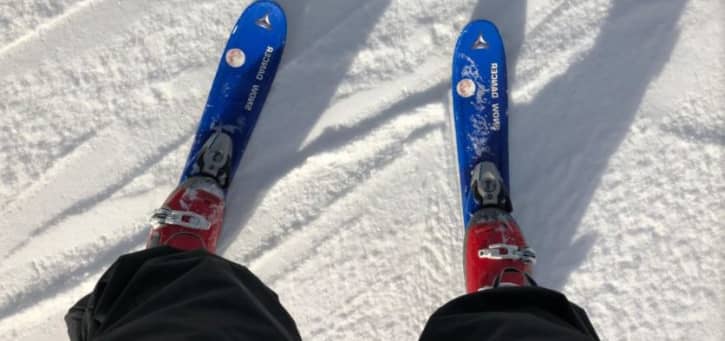No matter how you slice it, skiing is an expensive hobby. Of the associated costs, the most expensive parts are typically the skis, boots, and bindings. The cost of the insulating gear can also add up, but it's not that hard to stay warm while skiing on a budget.

If you're going on your first, second, or third ski trip, you're probably asking yourself whether you should rent or buy.
Below, we'll take a deep dive into the data (and other considerations) to help you make your final decision.
Contents
Should You Rent or Buy Skis?
It depends how often you go. According to the data we've analyzed, buying your own skis begin to pay for themselves after going skiing around 19 times. This means that if you ski 7 days out of the year, it will take you approximately two and a half years to pay off your skis. If you take a two-week annual ski vacation and stay on the slopes for 10 days, you'll be saving money by your second year.
Data Summary
Average Daily Rental Cost: $40
Average Ski Cost (with boots, binding installation and poles): $753
Approximate Ski Days Required to Become Worth It: 18.825
This does not include the cost of servicing your own skis, which can cost around $25-50 per year. This wasn't factored in because everyone is different in their diligence towards taking care of their skis. I personally have been guilty of not doing the proper tune-ups and maintenance when I should have, but it is something you should do for safety and longevity.
Keep in mind there are always ways to get cheaper skis. Shopping on clearance, looking at previous year models, and/or buying used can all chop down on the average pay-off time.
See Also: 77 Tips for a Cheaper Ski Trip
Advantages of Buying
Aside from cost savings in the long run, there are other advantages to buying skis that you might not think about.
- Saving time on rental lines: Whether you're renting at the resort or a separate ski shop, renting can be a lengthy process. This is especially true if the resort is crowded. It's pretty typical that it's over an extra hour before you get to actually hit the slopes when you consider the time it takes to wait, get fitted, and walk back and forth.
- Proper fit: Although most rental places do a decent job of fitting you for your skis and boots, having your very own is a far different experience. This is especially true if you get custom foot-beds, or insoles, in your boots.
- Practicing on the same skis: Even after a long off-season, there's a familiar feeling of clicking into the same skis. It's easy to get back on the mountain without skipping a beat. When renting, it's always going to take a bit longer to warm up.
Advantages of Renting
Believe it or not, renting has its own set of advantages, even for the advanced skier.
- Less expensive to travel: Traveling with skis can be expensive, especially if you're going to other countries. Many airlines will charge extra for additional bags, and you obviously won't be able to fit your skis in your normal luggage -- nor will they fit in the carry-on crate. You'll also have to buy an additional ski bag if you're going on a plane, which is another cost that's not factored into the initial calculation. If you're someone who plans on skiing in multiple countries, this is a cost you should definitely factor in.
- Getting to try the new and different models: Much like leasing a car, renting skis will give you the opportunity to try different and new skis on a regular basis. Not only do you get to try the latest and greatest, but you'll also get to try more advanced skis as you improve your skills. If you outgrow your first set of beginner skis, you're a bit out of luck unless you can sell them for a decent price.
- No maintenance or storage: If you rent skis, you don't have to worry about tune ups. You also don't have to worry about storing them, which can take up a lot of room if you live in a small place.
- Pick by Conditions: When you're renting skis, you get the luxury of picking different skis for different conditions. Say the conditions were really powdery, you could potentially rent yourself a pair of powder skis to help you float above the snow. While you should be able to do most things with all-mountain skis, variety is the spice of life, and it's fun to try new things.
Should You Buy Ski Boots Only?

Arguably, a set of boots that are custom-fitted to your feet and ankles are more important than skis.
There are several reasons for this:
- Customized flex: The flex of a ski boot refers to how difficult it is for the user to flex their ankle once they're inside of it. There are several different flex ratings, but no standard used across all manufacturers. That being said, you can't just pick an amount of flex that you like and then boots that have these exact properties. Generally speaking, more advanced skiers go for less flex for more responsive turning and carving. Beginners will go for greater flex for more comfort and warmth.
- Foot molding: A good boot fitter will actually work with you to get your boot molded perfectly to your exact foot shape. This usually involves some sort of heat treatment on the boot, which then allows it to mold to the user's foot. Boots from a rental shop are never going to have this level of custom fit which can result in less circulation, overall comfort, and usability.
- Custom insoles: Custom insoles provide support for the foot inside the ski boot. Because everyone's foot is so much different, a skier will rarely find that the standard insole from the boot manufacturer to be the ideal fit. Without the right insole, a skier can run into discomfort, restricted blood-flow, and less responsive skis.
For all these reasons, if you're going to ski regularly, you should still buy and custom-fit your boots at a reputable shop, even if you can't afford the skis.
Additionally, boots by themselves don't come with the same travel and storage complications that skis do.
See Also: Best Ski Boots for Wide Feet
Cost of Renting Skis Data
On average, the cost of renting skis (with boots, bindings, and poles) for an entire day is $40.
The cost of renting skis can vary depending on what state you're in and what mountain you go to. These were the methods I used to come up with an average:
- I sampled 25 different places to rent skis throughout the United States. These included resorts themselves or surrounding ski rental shops.
- The package had to include everything needed for one full day of skiing: boot, bindings, and poles. Some places threw in a helmet, but that was not considered.
- Multi-day packages were not considered, but generally the renter can save around $10 per day by renting for more than one day.
Resort / Shop Name | Cost* |
|---|---|
$52 | |
Aloha Park City (UT) | $50 |
Hunter Mountain (NY) | $41 |
Loon Mountain (NH) | $46 |
Mountain Creek (NJ) | $49 |
Christy Sports Aspen (CO) | $56 |
Sunday River (ME) | $41 |
Ski Sports Shack (MA) | $36 |
$35 | |
Killington (VT) | $55 |
$30 | |
$35 | |
$32 | |
$25 | |
Ober Gatlinburg (TN) | $25 |
Pro Fit Ski (VA) | $45 |
Crystal Mountain (MI) | $45 |
ASBCO (OH) | $17 |
Arizona Snowbowl (AZ) | $39 |
Tamarack Resort (ID) | $41 |
Big Sky (MT) | $48 |
Angel Fire Resort (NM) | $35 |
Powder Hounds (AK) | $45 |
Jackson Hole (WY) | $35 |
Tahoe Dave's (CA) | $32 |
AVERAGE COST | $40 |
*Cost reflective of time when article was written.
Cost of Buying Skis Data

On average, it will cost a a skier $753 for a decent beginner ski package which includes skis, boots, poles, and binding fitting and installation. Most of the data was sourced from Skis.com, which is a reputable ski retailer.
To get to this number, we analyzed several different beginner-friendly skis, boots, and poles and added an average of $50 for binding installation.
See the charts below for models and costs.
Average Ski Cost
Ski Model | Cost* |
|---|---|
Rossignol Experience 77A | $422.50 |
Rossignol Pursuit 200 | $259.97 |
Fischer XTR Pro MTN X | $359.99 |
Fischer XTR Pro MTN 77 | $399.99 |
Salomon XDR 78 | $399.99 |
Amphibio 76 | $399.99 |
Elan Explore 8 | $319.99 |
Dynastar Legend X | $599.95 |
AVERAGE COST | $395.30 |
Average Boot Cost
Boot Model | Cost* |
|---|---|
Rossignol Evo 70 | $179.95 |
Tenica Ten 2.0 | $199.95 |
Salomon QST Access 80 | $299.99 |
Fischer Cruzar 90 | $239.99 |
Salomon QST Access 70 | $249.99 |
Nordica Cruise 60 | $159.99 |
Head Advant Edge 85 | $239.2 |
Rossignol Track 90 | $299.95 |
Dalbello Jakk | $199.96 |
Alpina Elite 80 | $299.99 |
Dalbello Panterra MX 80 | $249.95 |
AVERAGE COST | $238.08 |
Average Pole Cost
Pole Model | Cost* |
|---|---|
Volkl Phantastick 2 | $47.2 |
Leki Spitfire S | $79.96 |
Leki Spark S Lite | $71.96 |
Salomon Hacker S3 | $64 |
Scott World Cup Strike | $89.1 |
Komperdell Fatso 7075 | $100 |
K2 Power Alluminum | $39.95 |
Line Chopstick | $63.96 |
AVERAGE COST | $69.51 |
*Cost reflective of time when article was written.
The Final Decision
At this point, you may have realized that buying your own set of skis, boots, and poles is going to be more expensive than you thought. While they certainly will pay for themselves in time, it's all a matter of how often you plan on skiing.
My recommendation is not to buy skis for your first season skiing -- hold off until you're more familiar with it. As you become a better skier, the trails, conditions, and destinations you want to hit are all going to change. Once you get a good idea of what you'd like to do, then you can make the plunge to get your very own set of skis.
But you should still get your own set of custom-fitted boots! You simply won't be able to get the same level of performance and comfort from renting them. Plus they're easy to travel with and are far more affordable.
Read Next: How to keep your legs warm while skiing






